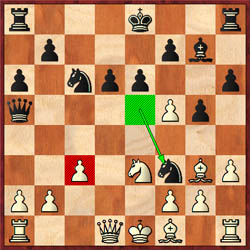 |
 |
 |
 |
 |
 |
 |
 |
 |
 |
 |
 |
|
|
|
|
|
|
|
|
|
|
|
|
|
 |
|
|
|
|

|
|
|
|
|
|
|
|
|
Round #5 Pairings
Svidler (Russia) - Topolov (Bulgaria)
Polgar (Hungary) - Morozevich (Russia)
Adams (England) - Kasimjanov (Uzbekistan)
Anand (India) - Leko (Hungary)
***
Round #5 Results
Svidler-Topalov, 0-1. There are not many superlatives left to describe how Topalov has been playing. Winning against Svidler is quite a feat given his minus score against the Russian. Furthermore, the Bulgarian widened his lead by 1½ points over both Svidler and Anand (who drew with Leko). This game repeated the opening from yesterday's Kasimjanov-Anand contest.
|
|
|
|
|
|
|
|
|
|
|
|
|
Svidler played 14.Ne3 instead of 14.fxe6 as in the aforementioned game and fell into 14… Qa5+ 15. c3 Nf3+! 16. Qxf3 Bxc3+ 17. Kd1 Qa4+ exposing the white king to mortal danger. When the skirmish ended, Topalov had a rook and two pawns vs. two bishops. Someone had compared Topalov to Emmanuel Lasker in that he will accept inferior positions if they are uncomfortable for the opponent.
Amazingly, black's pieces started to come alive while Svidler's pieces appeared to be confined to his first three ranks. GM Alexander Baburin, commentating at Chess.FM said that Topalov was "in the zone." It was really amazing to see the depth of Topalov's plans and the defenselessness of Svidler to prevent them. Another excellent move 31…Nh4! Stifled white's kingside while the black king's rook dominated play.
|
|
|
|
|
|
|
|

|
|
|
|
|
|
|
|
|
|
Still in the opening, Topolov uncorked 15…Nf3+! a move that was certain to get Svidler's attention.
|
|
|
|
|
|
|
|
|
|
|
|
|
|
|
Svidler tried to break free by simplifying with 39.Bxe6+ Ke6 40.Nc2+ Kd5 41.Nxb4 axb4. Topalov ended the game with a finesse shot 44…Rc4 and Svidler would be unable to stop black's passed b-pawn after 45.Rxh5+, so he resigned. Another amazing performance. (game)
Polgar-Morozevich, ½-½. This was the most exciting matchup of the round. Both players were attempting to break out of a "funk." Polgar would have the white pieces while Morozevich would be happy playing black given his two consecutive losses with white. The opening was weird and started 1.e4 d6 2.d4 Nf6 3.Nc3 d5!? Of course this Philidor/Hungarian Defense is a very old but solid line. Polgar got a comfortable position, but stood slightly better after 14…Rad1.
Polgar controlled the center, but Morozevich punched away with 27…f5!? The big moment of the game came when Polgar played the risky 33.Ng5?! after which Morozevich had options such as 33…Qxg3, 33…dxe5, 33…Bxd5 and 33…Qxb2. To the surprise of many, he opted for 33…Qxb2!? but a deeper look shows this move to be correct. After this, black was slightly better but with no concrete chances to press for the full point. Both sides sued for peace at move 41. (game)
Adams - Kasimjanov, ½-½. Kasimjanov appeared to be wearing one of Topalov's ties for good luck! Adams played his reliable 1.e4, but may have seen weaknesses in one of Kasimdzhanov's earlier games and decided to test his Najdorf. However, Adams opted for the positional 6.Be2 line instead of Polgar's 6.Be3 and 7.g4!? line. There was nothing special about this game. A positional battle without many hostilities. Adams had the advantage in space and it appeared as if his pieces were positioning for an attack, but he played 24.Nb6. The move was questioned and it was only moves later that he allowed three-fold repetition. Clearly these guys were not in a fighting mood today. (game)
|
|
|
|
|
|
|
|
|
|
.jpg)
|
|
|
|
|
|
|
|
|
|
Anand and Leko in a Sveshnikov battle!
(Photo by Casto Abundo)
|
|
|
|
|
|
|
|
|
|
|
|
|
Anand-Leko, ½-½. Trying in vain to keep pace with Topalov, Anand faced the first Sveshnikov of the tournament. Anand had blundered against Leko at the Corus tournament, but improved and thus, developed an advantage on the queenside. However, he played 25.Ra6-c6?! Some commentators suggested that the white knight would have been better placed on c6. Thereafter, the game heated up as Leko sought counterplay with 26…Qa5!
|
|
|
|
|
|
|
|
|
|
|
|
|
The game reached a critical point after 27. Na6 Ne4 28. b6 Qxd5 29. Qb5 Qd4, but instead of playing 30.b7! (diagram) 30…Nxf2 31. Qb6 Qxb6 32. Rxb6 Ne4 33. b8=Q, Anand opted for 30.Rc4 Rxc4 31. Qxc4 Nc3 32. Bd3 Qxc4 33. Bxc4 d5 34. Bxd5 and the game simplified into a theoretically drawn position with material on the same side of the board. However, Anand continued to press with his extra exchange (for a pawn), but Leko set up a fortress.
The last chance for Anand was to cause black's remaining pieces to come uncoordinated and pick off the f7-pawn. Baburin and IM William Paschall (Chess.FM) analyzed a number of variations where black could have lapsed into such a position, but Leko was able to keep the white knight from reaching a key attacking square and held quite comfortably. (game)
Standings:
1st Topalov, 4½-½
2nd-3rd Anand, Svidler, 3-2
4th Kasimjanov, 2½-2½
5th-6th Leko, Polgar, 2-3
7th-8th Adams, Morozevich, 1½-3½
|
|
|
|
|
|
|
|

|
|
|
|
|
|
|
|
|
|
Perhaps Anand missed his chances for a win with 30.b7!
|
|
|
|
|
|
|
|
|
|
|

|
|
|
|
|
|
|
|
|
 |
|


.jpg)

